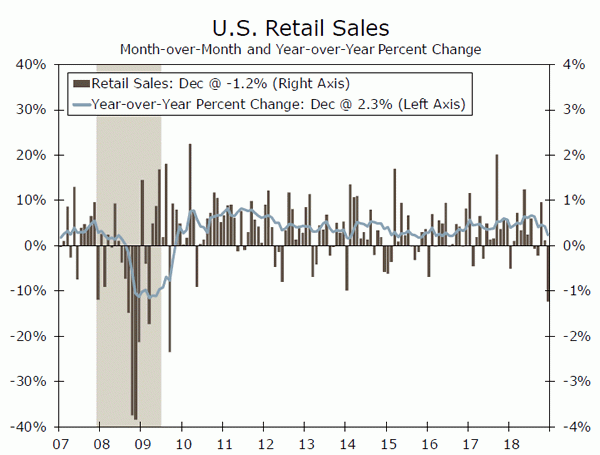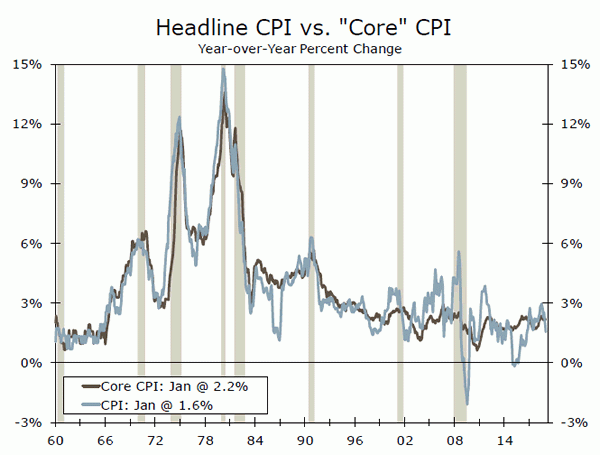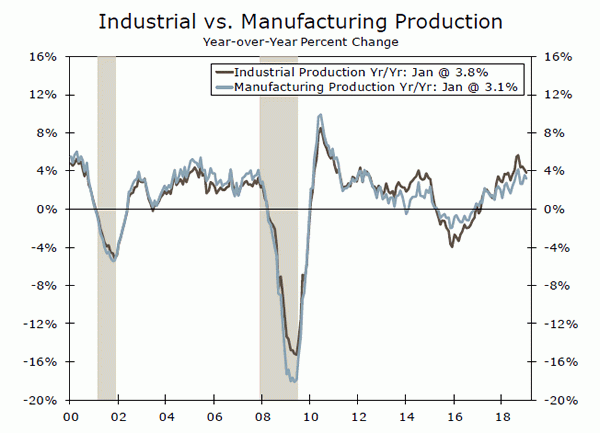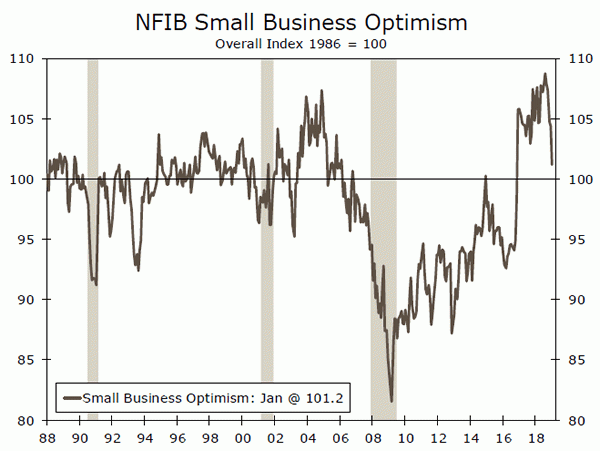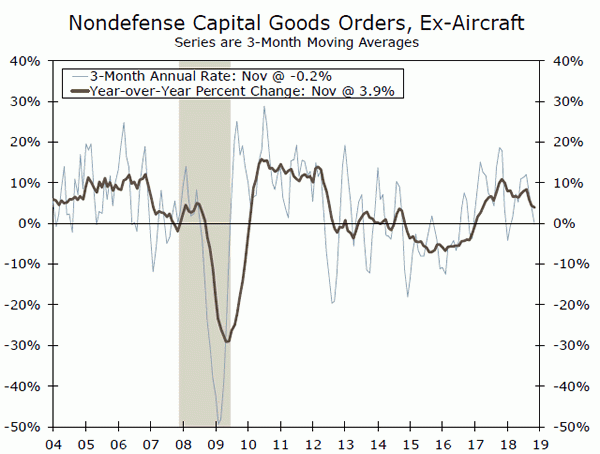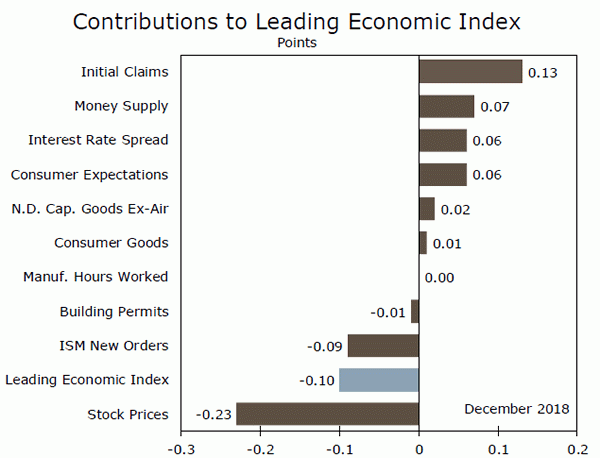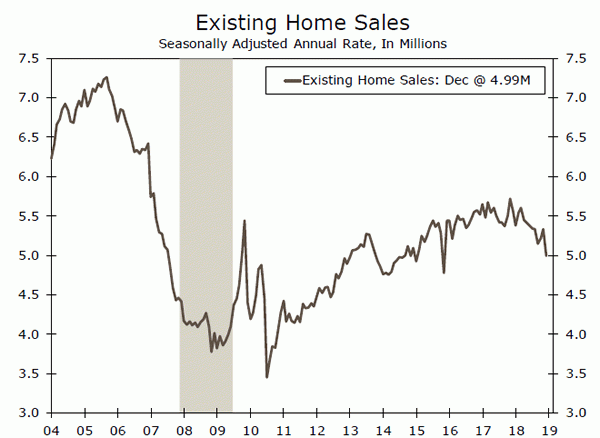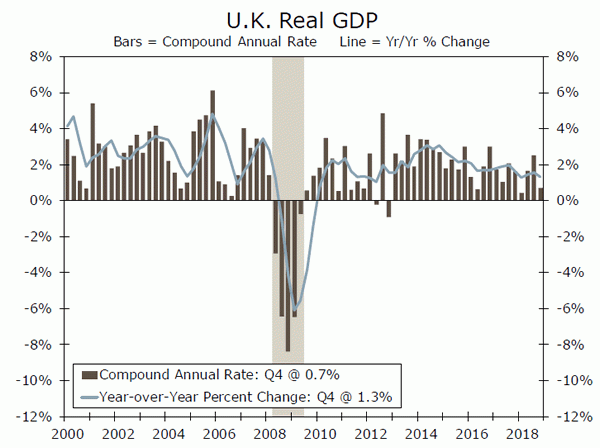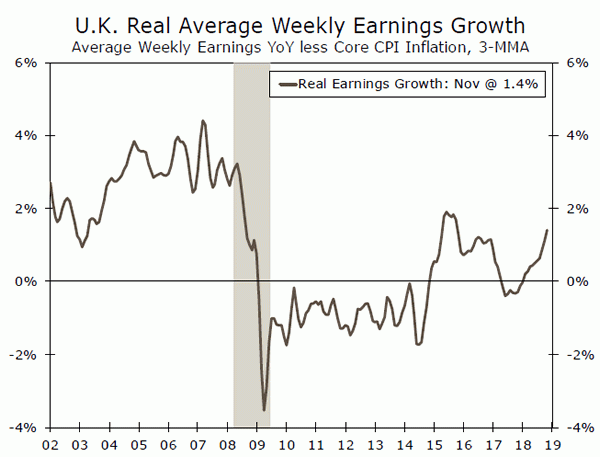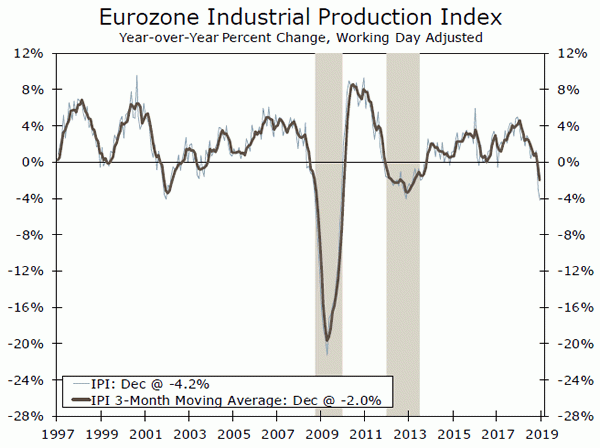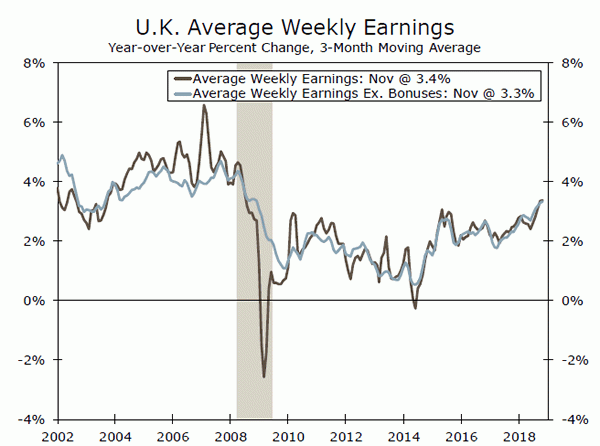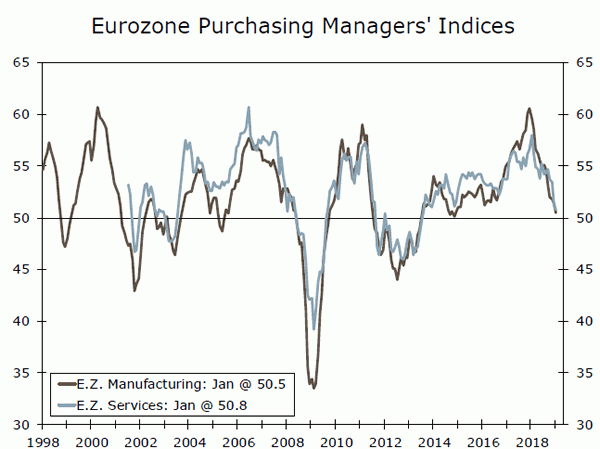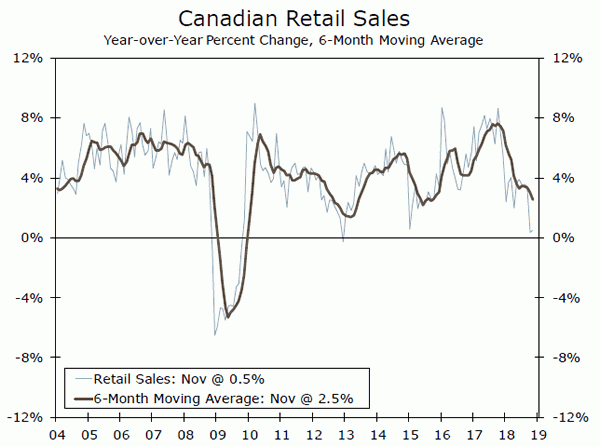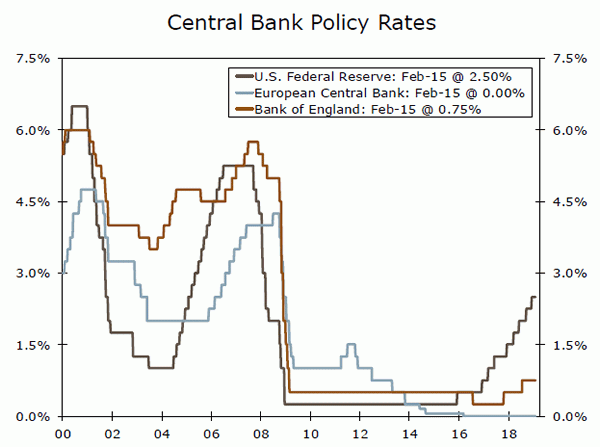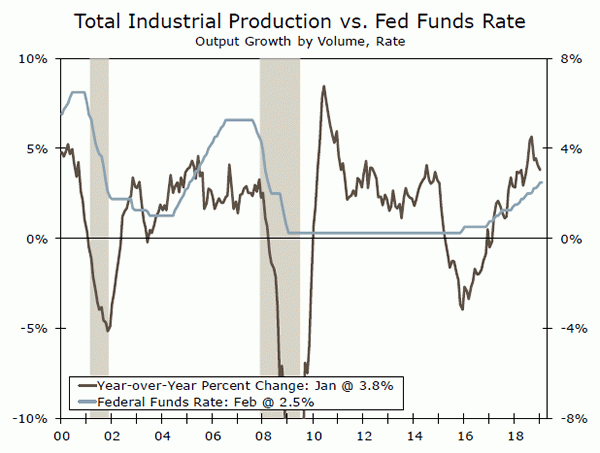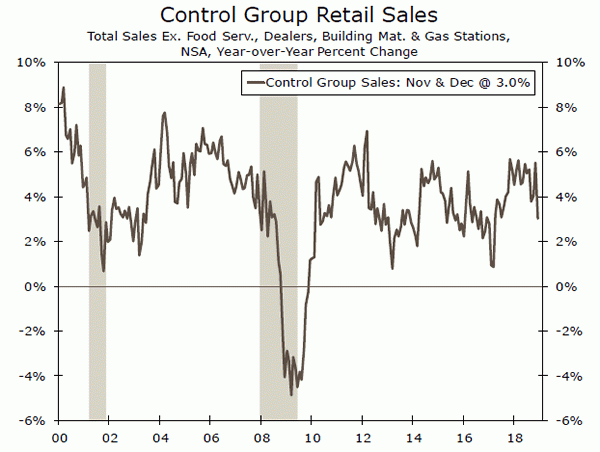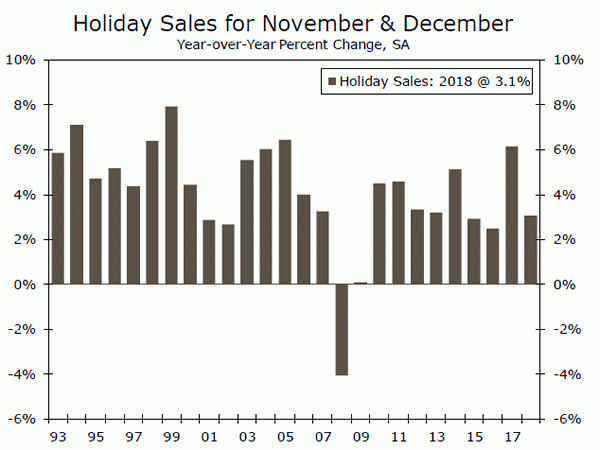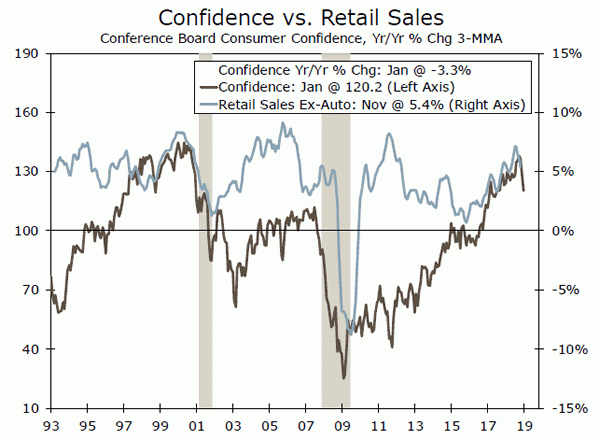U.S. Review
Retail Sales Go Rogue
- Energy prices weighed on both headline CPI and PPI. The January CPI was unchanged, while PPI fell 0.1%. Core measures were more firm, rising 0.3% and 0.2%, respectively.
- Retail sales unexpectedly plunged 1.2% during December. Control group sales, which factor into GDP, also sharply declined 1.7%.
- Industrial production fell 0.6% in January, with the weakness being traced to the manufacturing sector.
- The NFIB Small Business Optimism Index dropped 3.2 points in January amid uncertainty from the government shutdown.
Retail Sales Go Rogue
Another government shutdown appears to have been averted this week, which is good news as we are still catching up on the economic data postponed as a result of the December-January shutdown. Front-and-center was December’s retail sales report, which unexpectedly dropped 1.2%. Control group retail sales, which factor into GDP, also fell 1.7%, the sharpest decline since 2000. We view this report with a degree of skepticism, however consumer spending appears to have lost some momentum headed into 2019. Please see our Topic of the Week on Page 7 for additional detail on holiday sales.
Meanwhile, price pressures continue to be modest and in-line with the inflation goals laid out by the Fed. The headline consumer price index (CPI) was left unchanged in January, as lower overall energy prices weighed on the topline index. However, the less-volatile core measure rose 0.2% for the fifth consecutive month. Overall, core inflation continues to trend higher, yet remains contained with few signs of any sizable moves in either direction. Core inflation is up 2.7% annualized over the past three months, and has risen 2.2% over the past year.
A similar story played out for input prices. Lower energy prices led to a 0.1% dip in the producer price index (PPI). Core producer prices, which exclude energy and food, increased 0.3%. With inflation largely contained, the FOMC will likely feel less pressure to lift rates at its upcoming March meeting.
Industrial production (IP) also disappointed, falling 0.6% in January which was weaker than expected. The weakness can be tied to the 0.9% drop in manufacturing production, as both mining and utilities production experienced gains. In a separately released report, we learned that the NY Fed’s Empire Manufacturing Index rose to 8.8%, offering some hope for a near-term rebound in IP.
Small business optimism appears to have been adversely impacted by the shutdown. The NFIB index slipped 3.2 points to 101.2 in January, the lowest level since 2016. Financial market weakness towards the end of 2018 likely played a role, but uncertainty arising from the 35 day-long government closure clearly weighed on sentiment. The monthly decline also mirrors the steep drop in the Wells Fargo Small Business Survey to start the year. While optimism has faded somewhat, the index remains high relative to historical averages. More firms are reporting difficulty finding labor, which continues to signal a tight labor market. By contrast, firms have become somewhat less upbeat about the future and have expressed more guarded optimism surrounding the prospects for 2019.
Further evidence of a resilient labor market was also evident in the job openings data released this week. According to the JOLTS survey, there were over 7.3 million job openings in December, a record high. Furthermore, the number of job openings exceeded the number of jobless for the third straight month. Initial jobless claims have also mostly recovered from the uptick seen postshutdown. Claims for the week ending February 9 rose slightly to 239,000, but remain at an exceptionally low level.
U.S. Outlook
Durable Goods • Thursday
With funding for the Census Bureau restored, on Thursday we will get an overdue look at December durable goods data, originally scheduled for release on January 16. Nondefense capital goods orders, ex-aircraft, have been trending lower recently, and have fallen on a sequential basis three of the last four months.
The slowdown in business fixed investment spending suggested by the hard data is corroborated by forward-looking surveys of business capital spending intentions. The ISM new orders component plunged 10.5 points in December, the largest decline since January 2014, before rebounding in January. Similarly, the proportion of small businesses indicating plans to increase capital spending in December fell almost five points. The durables data for December will likely provide some perspective on the factory sector amid a moderation in business investment growth.
Previous: 0.7% Wells Fargo: 3.5% Consensus: 1.7% (Month-over-Month)
Leading Index (LEI) • Thursday
The Leading Economic Index reading for December was noteworthy for two reasons. For one, the government shutdown forced the Conference Board to estimate data on durable goods orders and building permits. Even with the Census Bureau back up and running, we are still flying blind with respect to new residential construction. Moreover, durable goods data for December will be published merely 90 minutes before the LEI on Thursday, suggesting that the index may again incorporate estimated values for these subcomponents.
Secondly, the 9% decline in the S&P 500 shaved 0.23 points off the headline, the largest drag from equity markets since January 2016. A decidedly more dovish Fed and recovery in investor sentiment have catalyzed a near complete retracement, with the S&P bouncing back 8% in January. Although the economic data haze from the shutdown has yet to fully clear, the easing of financial conditions should push the LEI back into positive territory in January.
Previous: -0.1% Wells Fargo: 0.1% Consensus: 0.2% (Month-over-Month)
Existing Home Sales • Thursday
Lower mortgage rates at the end of last year have yet to offer much of a reprieve for the housing market. Existing home sales dropped 6.4% in December, marking the fourth drop in the past six months and leaving sales down more than 10% on a year-ago basis. Adding to this picture of the slowdown, national price appreciation has cooled markedly to around a 5% pace and homes are now staying on the market for much longer.
Mortgage applications popped to start the year, with double digit increases the first two weeks of January raising hopes of a breakthrough in pent-up demand as a result of a rapid 50 bps decline in mortgage rates. This jump was followed, however, by four consecutive declines. Pending home sales, which tend to lead closings by two-to-three months, have similarly been down for five of the last six months. We expect a modest stabilization in sales in January.
Previous: 4.99M Wells Fargo: 5.05M Consensus: 5.00M
Global Review
More Subdued Data from the Global Economy
- U.K. GDP growth slowed more than expected toward the end of last year as business investment declined for the fourth-straight quarter, likely at least partly a symptom of Brexit uncertainty. Still, consumer activity has held up against a backdrop of stronger real wage growth.
- Eurozone industrial output figures pointed to a further slowing in activity in the currency bloc, while we also learned that Germany’s economy stagnated in Q4. Japanese GDP data showed a rebound in Q4 after a string of natural disasters in the prior quarter, although that rebound was not quite as strong as expected.
U.K. Economy Weakens Amid Brexit Concerns
The past week kicked off with the release of U.K. GDP figures, which showed the economy grew just 0.2% (not annualized) on a sequential basis in Q4-2018, while the year-over-year growth pace slowed to just 1.3%. The result was weaker than expected, and a closer look at the data suggests Brexit uncertainty may have contributed at least partly to the weakness during the quarter. Indeed, much of the weakness showed up in business investment, which fell 1.4% (not annualized) during the quarter, marking the fourth-straight quarterly decline. March 29, the deadline for a Brexit deal to be reached, is fast approaching and with no signs of a clear path forward from the U.K. government, businesses have had to operate in an increasingly uncertain environment. A series of votes in U.K. Parliament this week did little to reduce that uncertainty, with the next round of votes scheduled for February 27.
Meanwhile, consumer activity has generally held up better, as reflected in the healthy 0.4% (not annualized) increase in private consumption in Q4. Despite Brexit concerns, U.K. consumers have been helped by a steady climb in nominal wage growth while inflation has continued to slow, implying stronger real earnings growth (top chart). The latest figures released this week showed U.K. CPI inflation eased to 1.8%, the slowest since early 2017 and well below the 3%+ rates of wage growth seen in recent months. Still, while consumer fundamentals are strong, business investment—as well as overall growth—should remain subdued until there is a clearer resolution of Brexit uncertainty.
Elsewhere in Europe, more disappointing data were released in the Eurozone. Germany’s economy stagnated in Q4 after GDP declined in the prior quarter, while industrial output in the broader Eurozone fell 0.9% in December. On a year-over-year basis, industrial output declined 4.2%, the sharpest decline since the European debt crisis (middle chart). A closer look at activity in the industrial sector suggests that the weakness is more internally driven rather than a result of softer external demand. Indeed, industrial orders from non-Eurozone economies have remained fairly resilient, while orders from within the Eurozone have fallen sharply over the past year or so. It is still hard to square internal weakness in the Eurozone economy with highly accommodative monetary policy, generally neutral fiscal policy and strong real consumer income growth. Accordingly, we remain of the view that the currency bloc will see a near-term rebound in activity.
Japanese GDP figures were also fairly subdued (bottom chart). Real GDP in Japan rose 0.3% quarter-over-quarter (not annualized) in Q4, less than expected, after a sharp drop in activity in the prior quarter amid a string of natural disasters. The rebound was more pronounced in investment, as business spending climbed 2.4% over the quarter, although private consumption rebounded 0.6% during the quarter (both not annualized). Looking ahead, the pace of Japanese growth will be especially important to monitor ahead of a planned consumption tax hike in October. Growth will likely have to remain fairly robust ahead of any actual tax hike given the likelihood that a temporary drop in activity will follow.
Global Outlook
U.K. Employment & Wages • Tuesday
Amidst all the focus on Brexit, it has been easy to lose sight of actual data and macro developments in the U.K. economy. One trend of note has been the consistent acceleration in wages, which are now growing at their fastest pace of the current cycle. With productivity growth in the United Kingdom still subdued, the pickup in wages may become inflationary if businesses feel comfortable raising prices, while it could instead eat into corporate profits if consumer prices remain steadier.
The Bank of England (BoE) has taken note of this, and were Brexit uncertainty not hanging over the U.K. economy, it would probably have raised rates one or two more times in recent months. If Brexit is resolved by the end of March and if wage growth remains firm, we think the BoE could raise rates one or two times this year to head off inflation pressures.
Previous: 3.4% Consensus: 3.5% (Year-over-Year, 3-Month Moving Avg.)
Eurozone PMIs • Thursday
There is more attention than usual on developments in the Eurozone economy, with persistent weakness in activity and sentiment figures leading to concerns the currency bloc is heading toward recession. The purchasing managers’ indices (PMIs) for the manufacturing and services sectors have been steadily falling since last year, and are currently hovering just slightly above the 50-line demarcating expansion and contraction.
The mild upward revisions to last month’s PMI figures were a rare bright spot, but if these indices remain close to or below 50 on a consistent basis and activity data fail to show signs of a solid rebound, we would become more concerned about a potential Eurozone recession. Until then, however, we remain of the view that the economy will bounce back and grow close to potential in 2019.
Previous: Manufacturing 50.5; Services 51.2 Consensus: Manufacturing 50.3; Services 51.5
Canada Retail Sales • Friday
A wide range of indicators have pointed to softening economic growth in Canada in recent months, and retail sales has been no exception. On a year-over-year basis, retail sales rose just 0.5%, the slowest growth pace since 2012, while even through the monthly volatility the trend is clearly slower. Weakness in the country’s housing market could be one culprit for the slowdown in consumer activity—new home prices in Canada were stagnant on a year-overyear basis in November for the first time since the global recession.
However, the Bank of Canada (BoC) has also noted slow growth in oil-producing provinces amid lower oil prices as another possible source of the weakness in consumer activity. In all, the BoC will likely remain cautious in the weeks and months ahead until there are clearer signs of stabilization in economic activity. However, we still expect the central bank to hike rates two times this year as uncertainty dissipates and growth and activity turn around.
Previous: -0.9% Consensus: -0.0% (Month-over-Month)
Point of View
Interest Rate Watch
Rogue Wave?
December’s freakishly weak retail sales report raises questions about how much economic growth slowed late last year. The advance estimate shows sales plunging 1.2% in December and control group sales, which exclude sales at auto dealers, gasoline stations and building materials stores, fell 1.7%. Declines were remarkably broad based, with only two of the 13 major categories posting increases. Sales for November were also revised slightly lower.
The drop in control group sales was the largest since September 2001, when shellshocked consumers stayed away from the malls. The stock market sell-off, which hit a crescendo on Christmas Eve, may have dampened consumers’ spirit somewhat. But the drop in December retail sales seems way out of proportion to what we have seen in various measures of consumer confidence or reports from individual retailers.
We suspect the retail sales data are suffering from Seasonal Adjustment Disorder (SAD). Thanksgiving came exceptionally early this year so all Black Friday and Cyber Monday sales were captured in November. This may explain why sales at non-store retailers, which capture most online purchases, fell more in December (-3.9%) than department stores (-3.3%). Did Amazon really have a worse Christmas than Sears?
While seasonal adjustment may have exaggerated December’s slide in retail sales, we have found that even seemingly rogue economic numbers often contain important signals. Anecdotal reports confirm retail sales slowed in early December. Part of that slowing reflects sales being pulled forward into November but part was genuine. On a non-seasonally adjusted basis, control group sales for the past two months are up just 3.0% from their year-ago level.
The genuine slowing hinted by December’s weak retail sales was evident in January industrial production, which fell 0.6%. The first quarter is off to a sluggish start. Jay Powell’s shift toward a more patient and data driven policy now appears prescient. While we still see the Fed hiking rates in September, the debate appears to be shifting from when the Fed makes its next move to what that move will actually be.
Credit Market Insights
Foreign Investors Dropping U.S. Debt
Since the financial crisis in 2008, the share of U.S. Treasuries held by foreign investors has fallen 16 percentage points. The largest foreign holder of treasury securities, China, has reduced its holdings to $1.1 trillion in November 2018 from $1.2 trillion a yearearlier. Total outstanding U.S. Treasuries recently surpassed $22 trillion, with only $6.2 trillion held by foreign investors. China’s demand for U.S. Treasuries has decreased due to declining dollar reserves and increased costs of holding dollar assets. The second largest holder, Japan, owns $1.04 trillion, down from its $1.08 trillion holdings in November 2017. Like China, Japan has been reducing its holdings because of the rise in U.S. dollar hedging costs.
Meanwhile, the Federal Reserve has been gradually reducing its holdings of U.S. Treasuries on its balance sheet. Therefore, private investors now have to absorb more of the supply. This has led to concerns about the mounting debt and the ability to finance it. The most recent projections of the Congressional Budget Office suggest that deficits will exceed $1 trillion each year starting in 2022. Because of this, federal debt, as a percent of GDP held by the public is expected to reach the highest level since just after World War II. These projections could be more problematic if interest rates rise. However, domestic investors are expected to continue purchasing the government’s debt.
Topic of the Week
2018 Holiday Sales
The plunge in December retail sales meant that 2018 holiday spending was up only 3.1%. We say “only”, because we were expecting a 4.5% gain over 2017, which at 6.2% was the strongest holiday sales season in more than ten years. Difficult year-over-year comparisons, shaken confidence and the timing of the holiday season contributed to the softer-than-expected print last year.
Holiday sales are defined as sales at retailers (excluding gas stations, car dealers and bars & restaurants) which take place in the months of November and December. We had released our expectation for a 4.5% gain back in mid-October, when consumer confidence was at-or-near a cycle high (depending on the measure utilized) and the stock market was soaring to all-time record highs.
In the months since, confidence has pulled-back, as the year came to a close with wobbly equity markets, a partial government shutdown that stretched into the longest on record and unresolved trade tensions. The shaken confidence appears to have weighed on consumer spending in December more than we anticipated, but also more than leading indicators had suggested. The Redbook index, a high-frequency proxy for retail sales, was up close to 8% in December, the largest year-overyear gain on records that date back to the mid-1990’s.
There is also a case to be made that the early timing of Thanksgiving dragged holiday shopping into November. Holiday sales were up 0.8% in November, before declining 1.6% in December. An earlier-Thanksgiving, however, also meant there were four full weekends for shopping in December before the Christmas holiday.
We do not include October in our holiday sales calculation, but sales for holiday outlays in the month were up 0.4%. Being the strongest monthly gain in October since 2014, this could suggest consumers had shifted some of their holiday shopping forward.
With the weaker-than-expected sales print in December, we have cut back our expectations for real personal consumption expenditures in Q4 to 2.4% from 3.6% previously. Weakness likely also found its way into the first quarter, but we do not expect it to be sustained.




